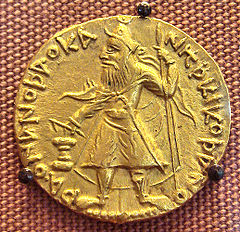迦腻色伽一世
迦腻色伽王一世(梵语:कनिष्क Kaniṣka,大夏语:Κανηϸκι,Kanishka I,在位期:公元127年-151年)是公元2世纪贵霜帝国的一个君主。他统一帝国,从中亚和犍陀罗一直延伸到恒河平原的帕塔利子城(Pataliputra)。他的帝国首都建在犍陀罗的白沙瓦(Peshawar),另一首都建在马国拉(Mathura)。在今贾巴尔普尔发现了迦腻色伽王的硬币。[1] 他对大乘佛教的赞助对丝绸之路的发展以及从犍陀罗穿越喀喇昆仑山脉到中国的传播发挥了重要作用。 大约在公元 127 年,他用大夏语取代希腊语作为帝国的官方行政语言。[2]

世系
编辑迦腻色伽王一世是月氏族贵霜。[3]月氏族的母语可能是吐火罗语 A。罗巴塔克铭文使用希腊文字来书写一种被描述为 Arya (αρια) 的语言 - 很可能是 Ariana 的一种大夏语,这是伊朗中部时期的伊朗东部语言。但亦很可能被贵霜采用以促进与当地臣民的交流。[4]
迦腻色伽王是威玛迦菲西(Vima Kadphises)的继任者。 迦腻色伽王与其他贵霜统治者的联系在罗巴塔克铭文中有记录,因为迦腻色伽王列出了在他那个时代统治的国王名单:Kujula Kadphises 他的曾祖父,Vima Taktu 是他的祖父,Vima Kadphises 是他的父亲,以及 迦腻色伽王本人。[5]
生平
编辑在吞并其他国家之后,定都于白沙瓦。之后鼎力宣扬佛教,并于在位期间统合佛教各部的思想,使大乘佛教产生其雏型。相传因为胁尊者的建议,他召开了第四次结集,相传《大毘婆沙论》也在他赞助下编成[6]。
征服南亚与中亚
编辑贵霜帝国的版图从乌兹别克斯坦南部和塔吉克斯坦延伸,西北部的阿姆河(阿克苏斯)以北到印度北部,直到东南部的马图拉(罗巴塔克铭文甚至声称他拥有帕塔利子城和斯里占巴),他的领土也包括克什米尔,那里有一个城镇 Kanishkapur(现代的 Kanispora),以他的名字命名,离巴拉穆拉山口不远,仍然包含一个大佛塔的底部。
《后汉书》记载,公元90年,班超率领70,000人与贵霜军(贵霜被称为月氏)在和阗附近作战,而贵霜军由一位不为人知的贵霜总督谢率领。班超取得胜利,以焦土政策迫使贵霜撤退。喀什、于阗和叶尔羌是中国在现代新疆塔里木盆地的属地。在塔里木盆地发现了几枚迦腻色伽硬币。[7]
迦腻色伽的贵霜帝国控制了南亚和罗马之间的陆地(丝绸之路)和海上贸易路线,使其版图与影响力四射。
-
迦腻色伽铜币, 在中国于阗发现。
迦腻色伽一世与佛教
编辑新兴的大乘佛教是在贵霜帝国之下大为发展并传播,大乘佛教也因此受到希腊文化或希腊罗马文化的强烈影响,如佛菩萨像的制造、建筑及雕刻等出现新样式与风格,即所谓犍陀罗艺术。犍陀罗佛像的雕刻是在西元一世纪的后半左右开始出现[11]正是大乘佛教出现时期。在佛教发展之初,虽然印度有高度的艺术发展,但因崇敬佛陀而没有制作佛像,只以菩提树等象征佛陀与佛法,另佛陀已般涅槃,因此佛陀当不可见,不能以形像来掌握的。但到了大乘佛教传播之时,信众祗求佛陀与菩萨救济在家苦难信众,拜佛求救苦众需要佛陀的具体形象礼拜,从此,在大乘佛教中,礼拜佛像也成了功德。
考证
编辑过去历史学家普遍认为他是大月氏人,但也有考证认为他应该是塞种(Saka)人。
迦腻色伽王一世在位28年。之后他传位与胡维什卡。但有关当时发生的事,由于年代久远及欠缺历史记录,详细情形已不为后人所知。
注释
编辑- ^ Dahiya, Poonam Dalal (15 September 2017). ANCIENT AND MEDIEVAL INDIA EBOOK. McGraw-Hill Education.
- ^ "The yuga of Sphujiddhvaja and the era of the Kuṣâṇas." Harry Falk. Silk Road Art and Archaeology VII
- ^ Findeisen, Raoul David; Isay, Gad C.; Katz-Goehr, Amira (2009).
- ^ Gnoli, Gherardo (2002). "The "Aryan" Language."
- ^ Findeisen, Raoul David; Isay, Gad C.; Katz-Goehr, Amira (2009)
- ^ 玄奘《大唐西域记》卷3〈迦湿弥罗国〉:“健驮逻国迦腻色迦王。以如来涅槃之后第四百年应期抚运。王风远被殊俗内附。……时王闻已甚用感伤。悲叹良久谓尊者曰。猥以馀福聿遵前绪。去圣虽远犹为有幸。敢忘庸鄙绍隆法教。随其部执具释三藏。……王乃宣令远近召集圣哲。于是四方辐凑万里星驰。英贤毕萃叡圣咸集。……又更下令。其有内穷三藏外达五明者住。自馀各还。于是得四百九十九人。……众会之心属意此国。此国四周山固药叉守卫。土地膏腴物产丰盛。贤圣之所集往。灵仙之所游止。众议斯在。佥曰允谐。其王是时与诸罗汉自彼而至。建立伽蓝结集三藏。欲作毘婆沙论。是时尊者世友户外纳衣。……时诸罗汉见是事已。谢咎推德请为上座。凡有疑议咸取决焉。是五百贤圣。先造十万颂邬波第铄论(旧曰优波提舍论讹也)。释素呾缆藏(旧曰修多罗藏讹也)。次造十万颂毘柰耶毘婆沙论。释毘奈耶藏(旧曰毘那耶藏讹也)。后造十万颂阿毘达磨毘婆沙论释阿毘达磨藏(或曰阿毘昙藏略也)。凡三十万颂。九百六十万言。……迦腻色迦王。遂以赤铜为鍱。镂写论文。石函缄封。建窣堵波藏于其中。命药叉神周卫其国。不令异学持此论出。欲求习学就中受业。”
- ^ Hill, John E. (2009) Through the Jade Gate to Rome: A Study of the Silk Routes during the Later Han Dynasty, 1st to 2nd centuries CE. BookSurge, Charleston, South Carolina.
- ^ "The Rabatak inscription claims that in the year 1 Kanishka I's authority was proclaimed in India, in all the satrapies and in different cities like Koonadeano (Kundina), Ozeno (Ujjain), Kozambo (Kausambi), Zagedo (Saketa), Palabotro (Pataliputra) and Ziri-Tambo (Janjgir-Champa). These cities lay to the east and south of Mathura, up to which locality Wima had already carried his victorious arm. Therefore they must have been captured or subdued by Kanishka I himself." Ancient Indian Inscriptions, S. R. Goyal, p. 93. See also the analysis of Sims-Williams and J. Cribb, who had a central role in the decipherment: "A new Bactrian inscription of Kanishka the Great", in Silk Road Art and Archaeology No. 4, 1995–1996. Also see, Mukherjee, B. N. "The Great Kushanan Testament", Indian Museum Bulletin.
- ^ Lo Muzio, Ciro. Remarks on the Paintings from the Buddhist Monastery of Fayaz Tepe (Southern Uzbekistan). Bulletin of the Asia Institute. 2012, 22: 189–206 [2022-05-31]. (原始内容存档于2021-11-05).
- ^ Samatata coin. British Museum.
- ^ 平川彰,印度佛教史
参看
编辑外部链接
编辑- 徐文明,《迦腻色伽王与大月氏王系 (页面存档备份,存于互联网档案馆)》,北京师范大学哲学系。
- 贵霜王朝早期的一些历史争议(英语) (页面存档备份,存于互联网档案馆)
- 贵霜王朝简史(英语) (页面存档备份,存于互联网档案馆)
- 迦腻色伽王一世时期的佛像钱币
延伸阅读
编辑- Bopearachchi, Osmund. De l'Indus à l'Oxus, Archéologie de l'Asie Centrale. Lattes: Association imago-musée de Lattes. 2003. ISBN 978-2-9516679-2-1 (法语).
- Chavannes, Édouard. (1906) "Trois Généraux Chinois de la dynastie des Han Orientaux. Pan Tch'ao (32–102 p. C.); – son fils Pan Yong; – Leang K'in (112 p. C.). Chapitre LXXVII du Heou Han chou." T'oung pao 7, (1906) p. 232 and note 3.
- Dobbins, K. Walton. (1971). The Stūpa and Vihāra of Kanishka I. The Asiatic Society of Bengal Monograph Series, Vol. XVIII. Calcutta.
- Falk, Harry (2001): "The yuga of Sphujiddhvaja and the era of the Kuṣâṇas." In: Silk Road Art and Archaeology VII, pp. 121–136.
- Falk, Harry (2004): "The Kaniṣka era in Gupta records." In: Silk Road Art and Archaeology X (2004), pp. 167–176.
- Foucher, M. A. 1901. "Notes sur la geographie ancienne du Gandhâra (commentaire à un chapitre de Hiuen-Tsang)." BEFEO No. 4, Oct. 1901, pp. 322–369.
- Gnoli, Gherardo (2002). "The "Aryan" Language." JSAI 26 (2002).
- Hargreaves, H. (1910–11): "Excavations at Shāh-jī-kī Dhērī"; Archaeological Survey of India, 1910–11.
- Hill, John E. (2009) Through the Jade Gate to Rome: A Study of the Silk Routes during the Later Han Dynasty, 1st to 2nd centuries CE. BookSurge, Charleston, South Carolina. ISBN 978-1-4392-2134-1.
- Kulke, Hermann; Rothermund, Dietmar. A history of India. London; New York: Routledge. 1998. ISBN 978-0-415-15481-9.
- Kumar, Baldev. 1973. The Early Kuṣāṇas. New Delhi, Sterling Publishers.
- Sims-Williams, Nicholas and Joe Cribb (1995/6): "A New Bactrian Inscription of Kanishka the Great." Silk Road Art and Archaeology 4 (1996), pp. 75–142.
- Sims-Williams, Nicholas (1998): "Further notes on the Bactrian inscription of Rabatak, with an Appendix on the names of Kujula Kadphises and Vima Taktu in Chinese." Proceedings of the Third European Conference of Iranian Studies Part 1: Old and Middle Iranian Studies. Edited by Nicholas Sims-Williams. Wiesbaden. 1998, pp. 79–93.
- Sims-Williams, Nicholas. Sims-Williams, Nicolas. Bactrian Language. Encyclopaedia Iranica 3. London: Routledge & Kegan Paul. Accessed: 20/12/2010 (页面存档备份,存于互联网档案馆)
- Spooner, D. B. (1908–9): "Excavations at Shāh-jī-kī Dhērī."; Archaeological Survey of India, 1908-9.
- Wood, Frances (2003). The Silk Road: Two Thousand Years in the Heart of Asia. University of California Press. Hbk (2003), ISBN 978-0-520-23786-5; pbk. (2004) ISBN 978-0-520-24340-8
| 前任: 阎膏珍 |
贵霜王朝君主列表 | 继任: 胡维什卡 |